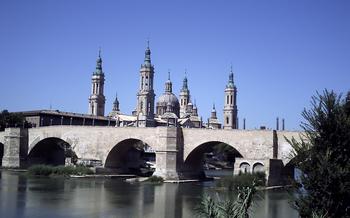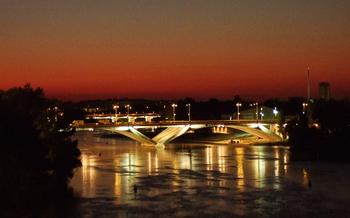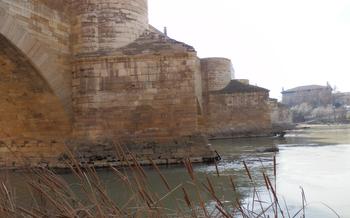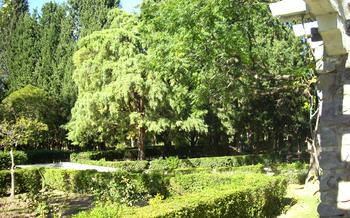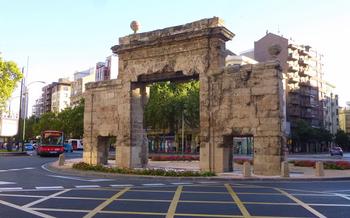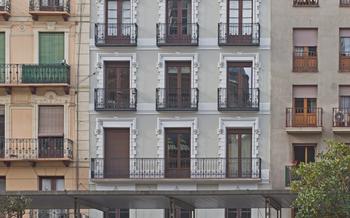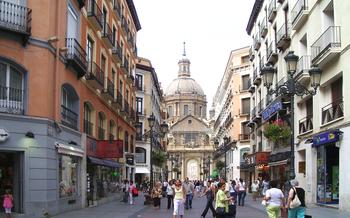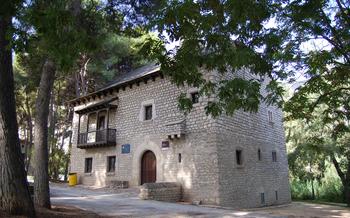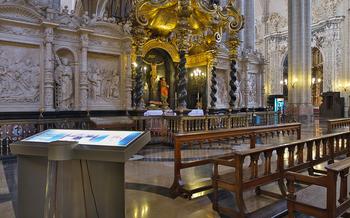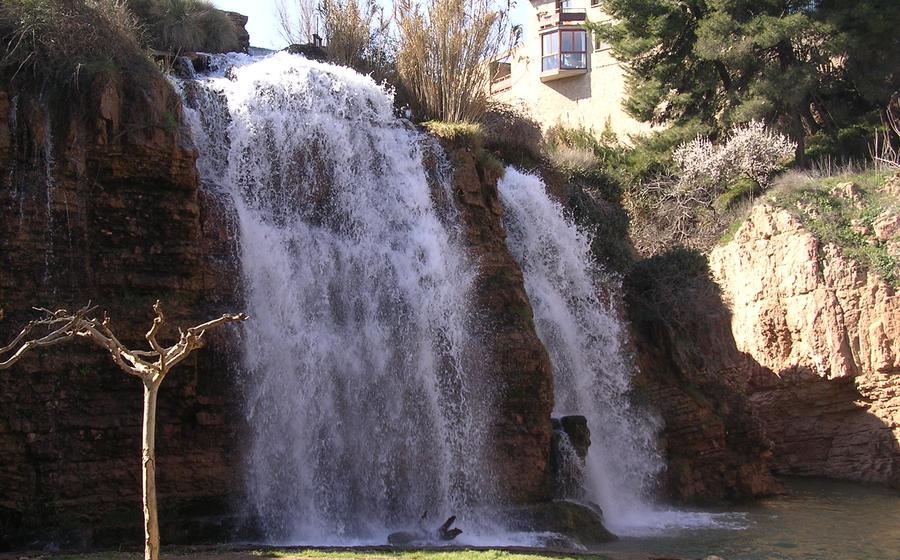
Río Huerva
- A River that Crosses the City
- The Huerva River Trail
- The Río Huerva Natural Park
- The Monasterio de Santa Engracia
- The Torreón de la Zuda
- Museo del Foro de Caesaraugusta:
- Acuario de Zaragoza
- Parque del Agua Luis Buñuel
- The Gran Vía
- Plaza del Pilar
- Catedral de La Seo
- The Palacio de la Aljafería
- The Ayuntamiento de Zaragoza
- Insider Tip:
A River that Crosses the City
The Río Huerva is a river that flows through the city of Zaragoza, Spain. It is a tributary of the Ebro River, and it plays an important role in the city's economy and culture. The river has a long history, dating back to the Roman era. In the Middle Ages, the river was used to power mills and to irrigate crops. Today, the river is a popular spot for recreation and tourism.
The Huerva River has had a significant impact on the development of Zaragoza. The river has provided a source of water for the city, and it has also been used for transportation and trade. The river has also been a source of inspiration for artists and writers. The riverfront is home to a number of parks, gardens, and museums. It is also a popular spot for people to go for a walk, run, or bike ride.
The Huerva River Trail
The Huerva River Trail is a must-do for anyone visiting Zaragoza. This gentle walk along the banks of the river offers stunning views of the river, the city, and the surrounding countryside. The trail is perfect for a leisurely stroll, a bike ride, or a run. Along the trail, you can find several parks, playgrounds, and picnic areas, making it a great place to spend a day outdoors.
One of the highlights of the trail is the Puente de Santiago, a 15th-century bridge that offers panoramic views of the city. Another highlight is the Monasterio de Santa Engracia, one of the oldest and most important monasteries in Zaragoza. The monastery is home to a number of important works of art, including the Visigothic Sarcophagi.
The Huerva River Trail is a great way to experience the natural beauty of Zaragoza and to learn about its rich history. The trail is well-marked and easy to follow, making it a great option for visitors of all ages.
The Río Huerva Natural Park
The Río Huerva Natural Park is a stunning natural oasis located just a few kilometers outside of Zaragoza. The park is home to a wide variety of plants and animals, including over 200 species of birds, making it a paradise for birdwatchers. Visitors can explore the park on foot, by bike, or even on horseback. There are also several picnic areas and playgrounds, making it a great place for a family outing.
The Río Huerva Natural Park is a great place to escape the hustle and bustle of the city and enjoy the peace and tranquility of nature. The park is also a great place to learn about the local flora and fauna. There are several interpretive signs throughout the park that provide information about the different plants and animals that live there.
Insider tip: If you are visiting the Río Huerva Natural Park in the spring, be sure to keep an eye out for the blooming wildflowers. The park is home to a variety of wildflowers, including poppies, daisies, and lupines. The wildflowers create a beautiful and colorful display that is sure to take your breath away.
The Monasterio de Santa Engracia
The Monasterio de Santa Engracia is one of the oldest and most important monasteries in Zaragoza. It was founded in the 6th century by Saint Engracia, a young woman who was martyred during the persecution of Christians under the Roman emperor Diocletian. The monastery was built on the site of her martyrdom, and it has been a place of pilgrimage ever since.
The monastery is home to a number of important works of art, including the Visigothic Sarcophagi. These sarcophagi are made of alabaster and they are decorated with intricate carvings that depict scenes from the Bible. They are some of the finest examples of Visigothic art in Spain.
The monastery is located on the banks of the Río Huerva, and it offers stunning views of the river and the city. It is a peaceful and serene place, and it is a popular destination for pilgrims and tourists alike.
Anecdote:
According to legend, Saint Engracia appeared to a shepherdess in the 13th century and told her to dig up her remains. The shepherdess did as she was told, and she found the saint's body buried in a field. The remains were then taken to the Monasterio de Santa Engracia, where they are still kept today.
The Torreón de la Zuda
The Torreón de la Z. It was built in the 11th century as part of the city's fortifications. The tower is a cylindrical structure with a diameter of 10 meters and a height of 25 meters. It has three floors, each of which is divided into several rooms. The tower was used as a prison during the Middle Ages**.
In the 16th century, the tower was converted into a watchtower. It was used to spot fires and other dangers. The tower was also used as a signal tower to communicate with other towers in the city.
Today, the Torreón de la Zuda is a museum. It houses a collection of artifacts from the Islamic period of Zaragoza's history. The museum also has a viewing platform that offers stunning views of the city and the Río Huerva.
The Torreón de la Zuda is a popular tourist attraction. It is located on the banks of the Río Huerva, near the Puente de Santiago.
Insider Tip: If you are visiting the Torreón de la Zuda, be sure to climb to the viewing platform for panoramic views of the city and the river.
Museo del Foro de Caesaraugusta:
The Museo del Foro de. The museum is dedicated to the Roman city of Caesaraugusta, which was founded in 24 BC, and houses a collection of artifacts from the Roman era, including statues, mosaics, and coins.
The museum is located on the banks of the Río Huerva, and its exhibits are arranged in chronological order, so visitors can follow the development of the city from its foundation to its fall in the 5th century AD. The museum also has a section dedicated to the everyday life of the Romans who lived in Caesaraugusta, with exhibits on food, clothing, and entertainment.
The Museo del Foro de Caesaraugusta is a fascinating glimpse into the history of Zaragoza, and it is a great place to learn more about the city's Roman past. The museum is open Tuesday to Sunday from 10am to 8pm, and admission is free.
Acuario de Zaragoza
The Acuario de Zaragoza is a fantastic attraction for people of all ages. It is home to a wide variety of fish and other aquatic creatures, including sharks, rays, eels, and jellyfish. The aquarium has several different exhibits, including a tropical rainforest exhibit, a Mediterranean Sea exhibit, and a shark tank.
One of the most popular exhibits at the aquarium is the Oceanarium, which is home to a variety of sharks, rays, and other large fish. Visitors can watch the sharks swimming through the water or get up close and personal with them in the shark tunnel. The aquarium also has a touch tank where visitors can touch and feel different sea creatures, such as starfish, sea urchins, and anemones.
In addition to its exhibits, the Acuario de Zaragoza also offers a variety of educational programs and activities. Visitors can learn about the different species of fish and other aquatic creatures that live in the aquarium, as well as the importance of protecting the environment. The aquarium also offers a behind-the-scenes tour, which gives visitors a chance to see how the aquarium operates and learn about the care and feeding of the animals.
The Acuario de Zaragoza is a great place to learn about the wonders of the underwater world. It is a fun and educational experience for people of all ages. The aquarium is located on the banks of the Río Huerva, a short walk from the city center.
Parque del Agua Luis Buñuel
The Parque del Agua Luis Buñuel is a unique and fascinating attraction in Zaragoza. It is an ancient water park that has been transformed into a modern-day cultural and leisure complex. The park is located on the banks of the Río Huerva and offers a wide range of activities for visitors of all ages.
The park is home to a large lake, which is a popular spot for swimming, boating, and fishing. There is also a large playground with swings, slides, and other activities for children. The park also has a number of restaurants and cafés, where visitors can enjoy a meal or a snack.
In addition to its recreational facilities, the Parque del Agua Luis Buñuel also has a number of cultural attractions. The park is home to the Museo del Agua, which tells the story of water in Zaragoza and its importance to the city's development. The park also has a number of sculptures and other works of art, which are scattered throughout the grounds.
The Parque del Agua Luis Buñuel is a great place to relax and enjoy the outdoors. It is also a great place to learn about the history and culture of Zaragoza. The park is open to the public every day and admission is free.
The Gran Vía
The Gran Vía is the main shopping street in Zaragoza. It is a wide, tree-lined boulevard that runs for over a kilometer from the Plaza de España to the Plaza del Pilar. The street is lined with a variety of shops, restaurants, and cafés, making it a great place to go for a stroll or to do some shopping.
Some of the most popular shops on the Gran Vía include Zara, Mango, H&M, and El Corte Inglés. There are also a number of souvenir shops and boutiques, as well as several art galleries. If you are looking for a place to eat, there are plenty of options to choose from, including tapas bars, restaurants, and cafés.
The Gran Vía is also a great place to people-watch. It is always bustling with activity, and you can see people from all walks of life going about their daily business. If you are looking for a lively and vibrant atmosphere, the Gran Vía is the place to be.
Insider tip: If you are visiting Zaragoza during the summer, be sure to take a walk along the Gran Vía in the evening. The street is lit up with festive lights, and the atmosphere is electric. You can also enjoy a drink or a meal at one of the many bars and restaurants that line the street.
Plaza del Pilar
The Plaza del Pilar is the main square in Zaragoza and one of the most important squares in Spain. It is located in the heart of the city, next to the Río Huerva, and is surrounded by some of the city's most important buildings, including the Catedral de La Seo, the Palacio de la Aljafería, and the Ayuntamiento de Zaragoza.
The square is a popular spot for tourists and locals alike, and it is often used for festivals and events. It is also a great place to people-watch and enjoy the city's atmosphere.
The Plaza del Pilar is a must-see for any visitor to Zaragoza. It is a beautiful and historic square that offers a glimpse into the city's rich past and vibrant present. Be sure to take some time to explore the square and its surroundings, and to soak up the unique atmosphere of this special place.
Catedral de La Seo
The Catedral de La Seo is one of the most important landmarks in Zaragoza. It is located on the Plaza del Pilar and is a beautiful example of Gothic architecture. The cathedral was built in the 12th century and is dedicated to Our Lady of the Pillar, the patron saint of Zaragoza. The cathedral is home to a number of important works of art, including the alabaster retablo of the High Altar, the tabernacle of the Holy Sacrament, and the tomb of Alfonso I of Aragon.
The cathedral is a popular tourist destination and is also a place of pilgrimage for Catholics from all over the world. Visitors to the cathedral can climb to the top of the tower for stunning views of the city and the surrounding countryside. The cathedral is also home to a museum, which houses a collection of religious art and artifacts.
The Palacio de la Aljafería
The Palacio de la Alja in Spain. It was built in the 11th century by the Banu Hud dynasty, who ruled Zaragoza at that time. The palace was used as a royal residence for over 500 years, until the Christian reconquest of the city in 111
After the reconquest, the palace was used as a royal palace by the Christian kings of Aragon. It was also used as a military barracks and a prison. In the 19th century, the palace was restored and converted into a museum.
The Palacio de la Aljafería is a UNESCO World Heritage Site. It is a beautiful and historic building that is a must-see for any visitor to Zaragoza.
The palace is open to the public and offers guided tours. Visitors can admire the beautiful architecture, the intricate carvings, and the stunning views of the city from the palace's towers.
The Ayuntamiento de Zaragoza
The Ayuntamiento de Zaragoza is one of the most important beautiful example of Renaissance architecture. The city hall was built in the 16th century and is one of the most iconic buildings in Zaragoza.
The Ayuntamiento de Zaragoza is the seat of the city government and is responsible for the administration of the city. It is also a popular tourist destination, and visitors can take guided tours of the building. The city hall is home to a number of important works of art, including paintings, sculptures, and tapestries.
The Ayuntamiento de Zaragoza is a symbol of the city's rich history and culture. It is a must-see for any visitor to Zaragoza.
Insider Tip:
If you are visiting Zaragoza during the summer, be sure to take a walk along the Río Huerva in the evening. The riverfront is lined with bars and restaurants with outdoor seating, and the atmosphere is electric. You can enjoy a leisurely stroll along the riverbank, stopping to sample the local cuisine and soak up the vibrant ambiance. As the sun sets, the city lights twinkle against the backdrop of the river, creating a magical and unforgettable experience. You can also take a boat trip down the river, offering a unique perspective of Zaragoza's landmarks and a chance to admire the city from a different angle. Whether you choose to stroll, dine, or sail, an evening by the Río Huerva is a must-do for any visitor to Zaragoza.
